In Switzerland more and more plant species originating from other regions, or even other continents, are making an appearance. When these species escape into the wild, and appear in large numbers, they can become a threat to indigenous species, cause economic damage or affect people’s health. In forests such species grow predominantly at lower warmer altitudes, near to settlement areas and are usually plants which have been purposely imported for horticultural use and which have then escaped into the wild.
Hardly a week goes by when the media does not report on a new animal or plant species which has appeared in Switzerland and has spread. Especially since the case of the common ragweed (Ambrosia artemisiifolia) the public has come to realise that changes in flora and fauna not only bring losers in terms of biodiversity loss, but also winners. And Ambrosia is not alone here. In the past decades various alien plant species have been able to spread rapidly in Switzerland. Have they also spread into the forests?
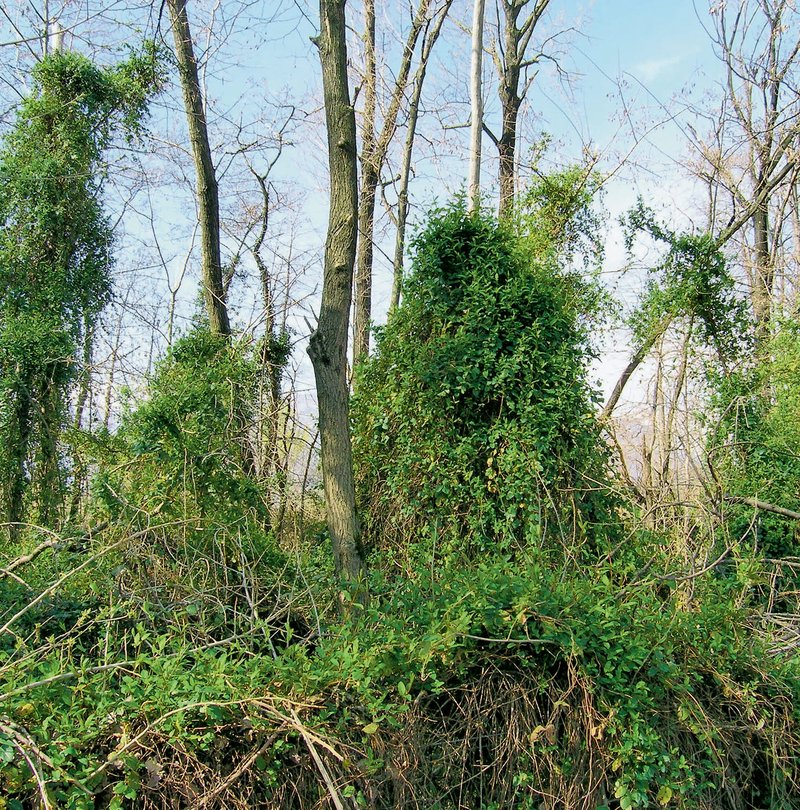
Fig. 1 - Japanese honeysuckle originates from East Asia and is a common invasive neophyte at lower altitudes in Ticino. However, only rarely does the vine grow up into the trees layers as in the above photograph taken near Locarno. Photo: Michael Nobis (WSL)
12% of vascular plants are neophytes
In Switzerland there are around 3’000 wild growing ferns and flowering plants (Lauber & Wagner 2007). The majority of these have spread into Switzerland from neighbouring areas since the last ice age. Therefore, the appearance and spread of alien species is not actually a new phenomenon. However due to globalisation and changes in the environment the number and dynamic of immigrant species, species consciously introduced into the country, has clearly increased. But unlike in the past these plants now originate from different regions of the world and a mix of flora and fauna, which were once widely separated, is now occurring.
Neophytes are plant species which have appeared in an area after the discovery of America. This is generally considered to be the starting point of travel and world wide trade. In Switzerland around 350 wild growing vascular plants, or approximately 12% of vascular plants, are neophytes and this percentage is constantly increasing. However, only a small number manage to spread out quickly over wide areas, penetrate the existing vegetation and build up large stands. Such species are described as being invasive - a characteristic which indigenous species, for example blackberries, also exhibit in forest rejuvenation areas.
In Switzerland, according to the Swiss Commission for Wild Plant Conservation (SKEW), there are at present (2008) 23 neophytes on the so called "Black List". These are considered especially invasive and cause economical and ecological damage or affect people’s health. A further 21 neophytes are on a warning list, the so called "Watch List". Both lists are constantly being updated by members of the University Botanical Institute, the Botanical gardens and the Cantonal Nature Protection Agencies, as well as the Federal Institute for the Environment (FOEN), Pro Nature, the Swiss Floristic Network Centre and the Federal Research Institutes.
Neophytes: alien species which have been introduced after 1500, or which appeared spontaneously and have in the meantime become established in the wild.
Invasive species: species which spread so quickly and intensively that they replace other species which are native to that habitat.
Source: SKEW
Where do neophytes appear?
Figure 2 shows the altitudinal distribution of Neophytes using current data from the Swiss Biodiversity Monitoring programme (BDM). It can be seen from the chart that neophytes are mainly to be found at lower altitudes. The number of such species is especially high in the canton of Ticino. Forests at lower, warmer altitudes, such as those in Ticino, are more likely to harbour neophytes than forests in mountainous areas.
In Switzerland lower altitudes with a higher forest cover have, on average, less neophyte species than areas which have a sparser forest cover (Fig. 3). This difference is due to the fact that neophytes are usually present outside of forests. Therefore, in built up areas in Zurich the percentage of neophytes is around 50% (Landolt 2001), whilst forests in the immediate vicinity have a percentage of only 8%.
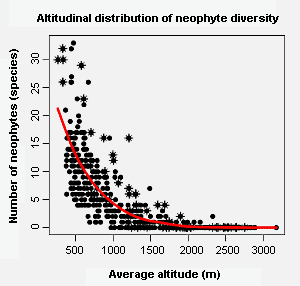
Fig. 2 - Altitudinal distribution of neophyte diversity in Switzerland (458 monitoring areas of Biodiversity Monitoring Switzerland, 1 km2 each, collected 2001-2006, so called Z7 indicators – "Species Diversity in Landscapes") Areas in Ticino are indicated by asterisks.
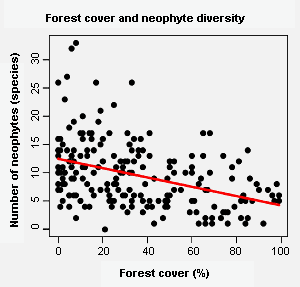
Fig. 3 - Relationship between neophyte diversity and forest cover in 205 BDM areas at lower altitudes (average altitude lower than 1000 m above sea level) not including the species richer diversity of Ticino.
As fewer neophytes are present in forests than in the surrounding areas it could therefore be expected that forests would present a barrier to the spread of many neophytes. However, some neophytes also occur in larger continuous forest areas. Here, they rarely appear in closed forests, but can be found along forest roads and edges and especially where the canopy is disturbed. Harvesting, as well as damage caused by fires, storms and alluvial dynamic can facilitate the spread of neophytes.
Under such conditions invasive neophytes, which grow outside of the forest, are able to spread into rejuvenation areas or into sparser forests therefore hindering forest rejuvenation. Such neophytes are often non-forest species, such as giant goldrod (Solidago gigantea) or Himalayan balsam (Impatiens glandulifera) and they usually diminish quickly as the young forest thickens.
Invasive forest neophytes
Invasive neophytes which are also considered to be forest species are listed on the "Black List" as well as on the "Watch List" (Table 1). They are referred to in the following, for purposes of simplification, as forest neophytes, although the species are not only limited to forests. What is particularly noticeable about these species, in comparison to the general neophyte flora of Switzerland, is that a large percentage are bushes (Cornus, Mahonia, Prunus, Viburnum) and vines (Lonicera, pueraria). Many of these are also, in contrast to indigenous flora, evergreen.
The most frequent species is the black locust which originates from North America and which appears as a neophyte especially in dry-warm places. Apart from the black locust there are other invasive alien tree species which appear locally or which are not (yet?) considered forest species in Switzerland. The tree-of-heaven (Ailanthus altissima), which originates from China and Korea, is a neophyte frequently to be found in settlement areas and along roadways or railway lines and sometimes in the forests of Ticino.
Table 1 – Invasive neophytes on the "Black list" and the "Watch list" which are present in forests (according to Landolt 1991, Delarze et al. 1999, Moser et al. 2002). The relative frequency refers to the 593 monitoring areas according to ZDSF, as well as, to 458 recordings from BDM samples. Non-determined species of neophytes are marked by a (?).
| Forest species on the "Black List" | ZDSF (rel. frequency in %) | BDM (rel. frequency in %) |
| Black locust (Robinia pseudacacia) | 41.5 | 12.2 |
| English laurel (Prunus laurocerasus) | 9.8 | 5.2 |
| Japanese honeysuckle (Lonicera japonica) | 5.9 | 1.3 |
| Armenian blackberry (Rubus armeniacus) | 1.7 | (?) |
| Black cherry (Prunus serotina) | 1.3 | 0.9 |
| Kudzu (Pueraria lobata), up to now only invasive in Ticino | 0.7 | 0.0 |
| Forest species on the "Watch-List" | ||
| Oregon grape (Mahonia aquifolium) | 5.4 | 2.8 |
| Wrinkled viburnum (Viburnum rhytidophyllum) | 2.4 | 1.1 |
| Redosier dogwood (Cornus sericea) | 1.9 | 1.3 |
| Windmill palm (Trachycarpus fortunei), up to now only invasive in Ticino | 1.3 | 0.7 |
| Henry’s honeysuckle (Lonicera henryi) | 1.0 | (?) |
Diagram 4 shows a map of country- wide know occurrences of the above listed neophytes. Apart from the distribution data from the ZDSF data from the smaller recording areas of the BDM are also shown. The map shows that invasive forest neophytes are present at lower altitudes all over Switzerland. In Ticino they are especially numerous – even in the smaller BDM areas.
However, at lower altitudes in Northern Switzerland they are rarer and are often absent from the BDM areas. The ZDSF data show focal points in the towns (Zurich, Basel, Lausanne, Geneva) but this is partly due to the better information situation there. For instance data on the Armenian Blackberry (Rubus armeniacus, see below) had mainly been collected in the Zurich area, although this species is known to have a much larger distribution within Switzerland. Knowledge about the present speed of spread of alien species is often inadequate.
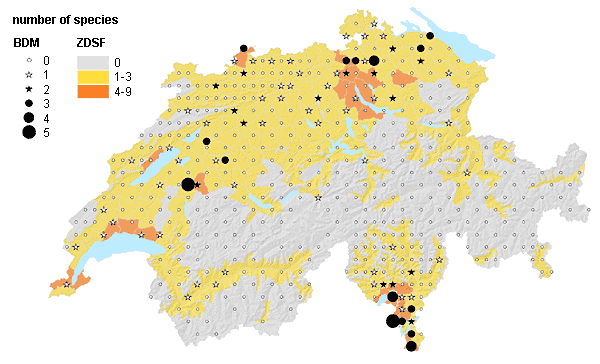
Fig. 4 - Distribution of invasive forest neophytes (see Table 1).
Importance of Proximity to settlement areas
Is it therefore possible to find a universal law for the appearance of invasive forest neophytes? Results from standardised recorded BDM data show a clear relationship between the appearance of these species and the settlements in a monitoring area. (Fig. 5) In the BDM data the presence of wild but not cultivated plants is taken into account. Although countrywide the existence of invasive forest neophytes is facilitated by higher temperatures in the north of Switzerland the proximity to settlement areas is without doubt the most important factor. This can be understood when the paths taken by a species when spreading are taken into consideration. Apart from the black locust, which has been promoted in forests for over 200 years, all of the species named in Table 1 are used for urban greening. From this source the species are able to spread into the nearby forests; the proximity to settlement areas is therefore the deciding factor for their spontaneous appearances.
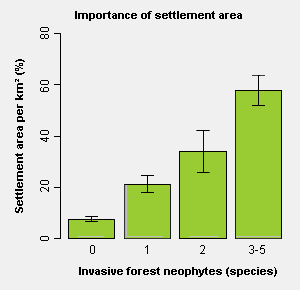
Fig. 5 - Relationship between the appearance of invasive forest neophytes and the settlement (BDM recordings at lower altitudes; not including the species rich recordings from Ticino; average settlement percentage stating the standard error).
An example of an invasive forest neophyte spread pathway can be seen in Fig. 6. Henry’s honeysuckle (Lonicera henryi), which is available from garden centres and is often used for greening around buildings, has spread into nearby forests. The vine behaves in a similar way to the Japanese honeysuckle (Lonicera japonica), an invasive forest neophyte, which is widely distributed in the Ticino and has in certain areas even grown into the tree layers. (Fig. 1).
A further example is Fig. 7 – the already mentioned Himalayan blackberry (Rubus Armeniacus). This is also an invasive neophyte (Black List) which is planted as a fruit plant in gardens. This blackberry has spread from the forests onto industrial sites or along railway lines and is causing increased maintenance costs. The Armenian blackberry is sturdier than the majority of indigenous blackberry species and can be found on the edges of forests and even in rejuvenation areas within forests.
Blackberries are regarded as a problem species in silviculture causing increased costs in the care of young forests. These are is usually indigenous blackberry species, but it can be expected that the Armenian blackberry will spread out further along forest edges and into young forest areas. In Figure 7 this species can be seen together with raspberries (Rubus idaeus) in a rejuvenation area. This example shows that invasive neophytes are not always immediately noticeable, even when using the word “exotic” when talking about them.
Increase in Neophytes expected
Although locally restricted invasive neophytes present in the Swiss forests are an important factor to be considered. The forests in the Ticino are especially affected although certain species are also appearing in northern Switzerland. Their presence is promoted by proximity to settlement areas, high temperatures and sparse or damaged forest areas. Due to climate change – including the expected increase of disturbances caused by storms and fire – and due to the use of alien ornamental plants in horticulture, the growth of settlement areas and the spontaneous spread of non-native species gone wild means that the importance of neophytes in the forest will also increase.
It is therefore important to carefully record and evaluate further developments, to take measures early enough to hinder the spread of invasive neophytes. Switzerland has already committed itself to this aim in national and international agreements and through legal provisions (such as Release Ordinance, Biodiversity Convention of Rio, etc). In regard to the forest the use of invasive neophytes in horticulture must be called into question. If in the future even bigger economical and ecological damage should be caused by these species outside of settlement areas, then these would truly be problems of our own making.
Translation: Dawn Meister (Affoltern a. A.)
Literature
- Delarze, R., Gonseth, Y. und Galland, P., 1999: Lebensräume der Schweiz. Ott Verlag, Thun.
- Landolt, E., 1991: Gefährdung der Farn- und Blütenpflanzen in der Schweiz. BUWAL/EMDZ, Bern.
- Landolt, E., 2001: Flora der Stadt Zürich. Birkhäuser Verlag, Basel.
- Lauber, K. und Wagner, G., 2007: Flora Helvetica, 4. Aufl., Haupt Verlag, Bern.
- Moser, D.M., Gygax, A., Bäumler, B., Wyler, N. und Palese, R., 2002: Rote Liste der gefährdeten Arten der Schweiz: Farn- und Blütenpflanzen. BUWAL/EMDZ, Bern.

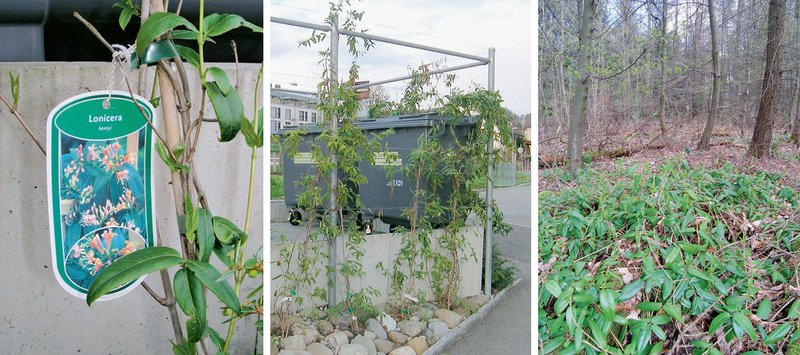
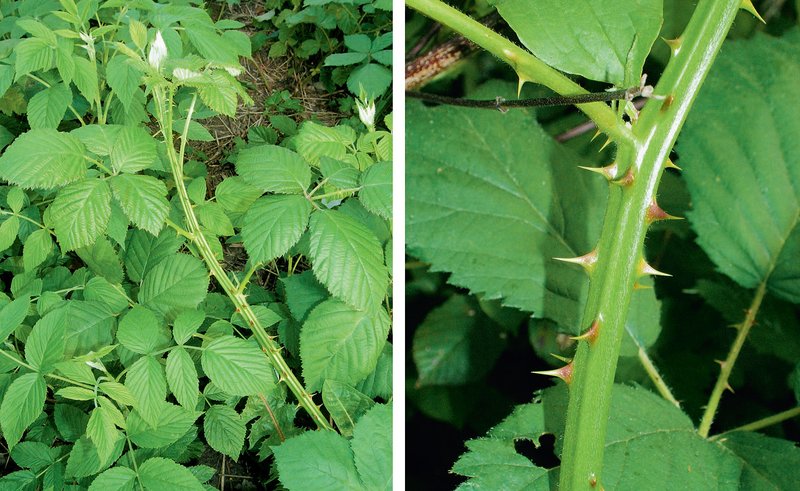
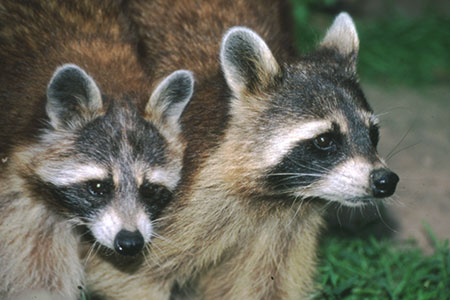
![[Translate to English:] [Translate to English:]](/assets/_processed_/6/e/csm_wsl-merkblatt-alb-1_338dbd89ab.jpg)